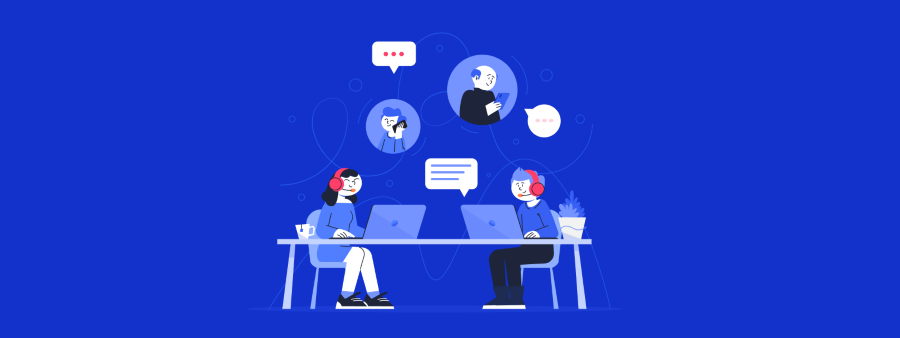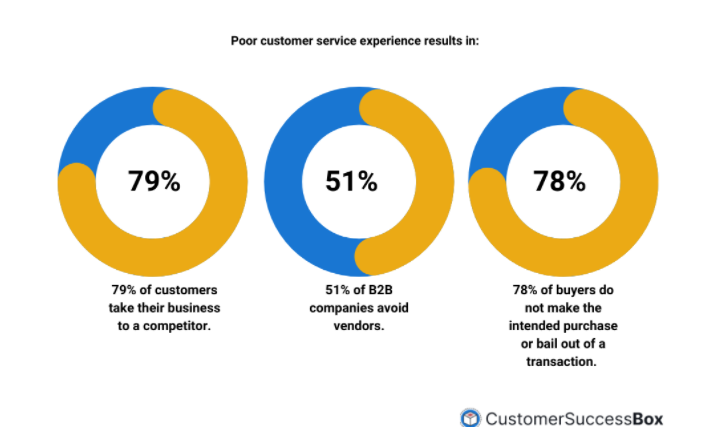Customer retention is an incredible and indispensable part of any sustainable business. According to research from Harvard Business School, increasing customer retention rates by only 5% increases a company’s profits by 25-95%.
Customer Success (CS) is a relatively young but rapidly evolving function in today’s B2B SaaS world whereas Customer Support has always been an important part of businesses for a long time. Both the functions are separate, however, they do overlap at some points and contribute to driving customer retention.
Customer success skills and customer support skills are different from each other in myriad ways. It is not uncommon nowadays for customer success to be looked up to as the driver of every aspect of client experience and satisfaction that stems out from customer interactions, while the support department is treated as a reactive cost center.
However, if the success and support teams are aligned to work together to achieve a positive customer experience, customer retention will be the best consequence.
Let’s look at some of the other important retention statistics that lay emphasis on the importance of customer retention.
- “79% of the customers would take their business to a competitor within a week of experiencing poor customer service” – Strikedeck
- “For every customer who complains, there are 26 other customers who instead of vocalizing their frustrations to the Support team, simply stop buying from you”- Bain & Company
- “51% of B2B companies avoid vendors after a poor customer service experience.” – Zendesk
- ”Over 72% of the businesses say that improving customer success would be their number one priority”- Forrester
- 86% of buyers will pay more for a better customer experience. – SmartKarrot
- 89% of businesses, “see customer experience as a key factor in driving customer loyalty and retention.”- Huify
For SaaS businesses, the key is to focus on more numbers and statistics for customer retention. It’s equally important to know how to calculate customer retention rates and implement retention strategies promptly.
Differences between Customer Support and Customer Success.
Now that we understand the importance of customer retention in B2B businesses, it’s necessary to understand what contributes to the same. Customer success and customer experience are the departments that discharge crucial functions to improve retention, thereby, customer satisfaction.
Before we dive deeper into the details, let’s first understand how the two functions differ from each other.
Customer Success is a collaborative effort and support is basically technical in nature. For a customer success professional, a variety of skills are essential to be successful in the field. However, the skills of a customer support specialist are well understood.
The following table clearly points out the key differences between CS and support functions.
|
Feature |
Customer Success |
Customer Support |
|
Approach |
Proactive |
Reactive |
|
Duration |
No terminal point |
Transactional |
|
Timeline |
Long-term |
Short-term |
|
ROI |
Increased revenue |
Operational cost |
|
KPIs |
Portfolio growth, CLV |
CSAT, etc. |
|
Team |
Cross-functional teams |
Single team |
|
Focus |
Customer desired outcome |
Fixing issues |
Approach
Customer Success is proactive in nature which means you need to ensure that problems do not arise in the first place. Also, the main goal of a CS function is to help the customer achieve their desired outcome. Customer support professionals will need to fulfill the needs of the customers by providing the best experience. This is a reactive approach as they react to the customer’s needs.
Duration
This basically focuses on the point that a customer success professional has a lifelong (as long as a client is with the business) relationship with the customer. Whereas, customer support interactions are transactional in nature. The interactions continue until the customer gets his/her issues resolved.
Timeline
As already mentioned, the customer success interactions continue until the customer is with the business. Since the goal of a CS personnel is to help the customer in achieving his/her desired outcome, the relationship, therefore, continues until it’s achieved. Support professionals need not interact with the customer for long. The client requires their assistance only if a problem crops up. Hence, the relationship is purely based on the client’s needs.
ROI
Customer Success doesn’t have definite proof of its impact on ROI (return on investment). Since the CS is still evolving as a function, its effect is not directly measurable. However, professionals across the world believe that if the function was to disappear, it would significantly increase customer churn and reduce retention. Support functions, on the contrary, are well understood and are viewed as an operational cost- a much-needed one!
KPIs
Customer success tries to measure the impact on downstream business revenue. The KPIs such as portfolio growth, customer lifetime value (LTV), customer repeat purchase rate, etc. are some of the most important ones. Support function aims to measure the speed and the quality of the tickets raised with the help of metrics such as CSAT, NPS, etc.
Team
The CS team is often grouped together with the sales team. However, for the function to be successful and improve results for the business, it usually collaborates with other teams such as the product, marketing, and of course the support team as well. On the other hand, the support team plays on its own with the sole responsibility of closing the tickets within the agreed SLA.
Focus
The focus of a CS team or the professional is on helping the customer achieve his/her desired outcome whereas it’s simply fixing issues faced by the customer for the support team.
Suggested Read: The key differences between customer success and customer experience functions are important to understand to know how can you approach the functions to provide extraordinary customer service.
The Key to Customer Retention is Customer Satisfaction
And, if both the departments-the customer success and support- work together, they can increase customer satisfaction and hence, drive customer retention.
In B2B SaaS you spend anywhere between 1 – 3X times the Annual contract value (ACV) as your Cost of Acquiring the Customer (CAC). The plan is to retain and grow the recurring revenue from these customers for many years to come. That is fundamentally how retention in the SaaS world is different.
Retention is baked right into the foundation of the SaaS business model. It is no secret that a SaaS model without good retention is not sustainable.
A SaaS customer only pays 5-15% of total potential Lifetime Value upfront, the rest will only come in as future revenue only if you’re able to retain that customer. Wondering How?
The following tips & tricks would help you with devising strategies to drive customer retention. However, it is much easier to view retention through a “customer satisfaction” lens. As already mentioned, both the functions-customer success and customer support do overlap each other and that is where the customer satisfaction and retention lie (hiding in plain sight).
Define your retention strategy
Retaining customers doesn’t happen overnight. It requires consistent efforts from the team from day one since the customer is onboarded. You need to have a strategy to keep your existing customers from walking away! The customer retention strategy:
- Helps in defining each step of the way.
- Helps in addressing customer concerns before they appear.
- Entails loyalty programs that make them feel appreciated and valued.
- Helps in delivering more than promised
Listen to and understand your customers
You might believe that your customer service is a superior one. However, your customers might respond differently to the above statement. The issue of different perspectives comes to the fore. Focus on your customer support by listening to them. If you pay attention to their concerns, you will have your customer retention strategy right there!
Provide real-time response with visual engagement tools
Customer Success technology can make or break your SaaS success. The right customer success tools will help you in identifying key retention metrics, and eventually, solve any potential issue even before it crops up.
An AI-powered CS tool like CustomerSuccessBox would be an excellent technology to retain your customers. The platform provides data necessary to provide real-time customer behavior information which in turn helps you in taking actionable steps to prevent customer churn.
Always keep an eye on your customer
In the subscription economy, we all are in, businesses need to constantly provide the best customer experience to keep their customers with themselves. You need to pay close attention to what they’re saying about you.
Give discounts and other benefits
This is one of the best ways to retain a client. Provide discounts to your long-term customers and free ancillary services, wherever possible, to keep them hooked on your brand for the longest time. It makes them subconsciously loyal to you as they know they’ll be getting more value than promised.
Be transparent
You need to be honest and totally transparent with your customers. That would be the best strategy which will go a long way in enhancing customer satisfaction and loyalty. Having healthy and simple conversations is enough to keep them engaged. Constant touch basing with the customer ensures that they open up to you about any issue that they face if any.
Work out on a consistent Customer Experience.
Providing an extraordinary customer experience always pays off. However, it shouldn’t be a one-time event. Keeping that streak up is what will keep your customers with your brand for as long as possible.
“87% of customers think brands need to put more effort into providing a seamless customer service experience.”-Zendesk research. Providing such consistent CX can be advantageous as it will make sure that the customers are satisfied.
Maintain a synchronized multi-channel experience
It is vital to maintain a synchronized and seamless experience across all the communication channels like social media, emails, phones, etc. while interacting with the customers. It can also be defined as the “Omni-channel customer service”. They expect it.
It’s important for you to understand how they interact with your brand across all the channels so that you can optimize the relevant processes. This will ensure that all the gaps are filled and your customers get the value that they were looking for.
It will make them happy and they’ll stick around. Consistent customer experience will make them even happier and they won’t churn!
Manage and, if possible, exceed expectations
Expectations play the game here. Everything starts and ends there. Try to set up realistic expectations so that they either don’t very excited or they don’t feel too depressed to leave your business and go somewhere else. Simply put- ‘underpromise and over-deliver.
Ask for feedback
Getting to know if the customer is happy, is s/he able to get the promised value, whether the customer needs any sort of assistance going forward, etc. are some of the most vital parameters. If you want to boost customer retention, then you need to know where the customer stands to take actionable steps.
Adopting different customer retention practices is crucial. You need to understand what are the customer retention strategies for further knowledge on strategies for an effective customer retention program.
Final thoughts on how client success and customer support can drive retention
Customer retention is the lifeblood of a B2B SaaS business. Ensuring your customers don’t churn requires a deep level of understanding-about the customers-from your end. Consistent efforts need to be made in the direction of both Customer Success and support teams.
Client Success or Customer Success and customer support are inherently different. However, the truth is that the success and support team need to have shared goals to drive retention. This leads to both teams jointly delivering more value to your customers, improving satisfaction and loyalty, and increasing retention.
The key differences should be kept in perspective while aligning both departments on a shared goal of customer retention.





